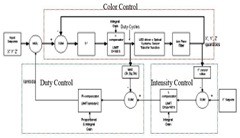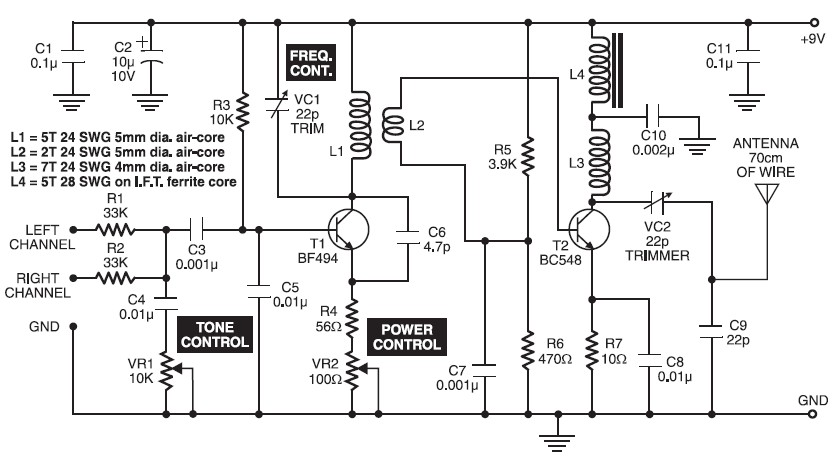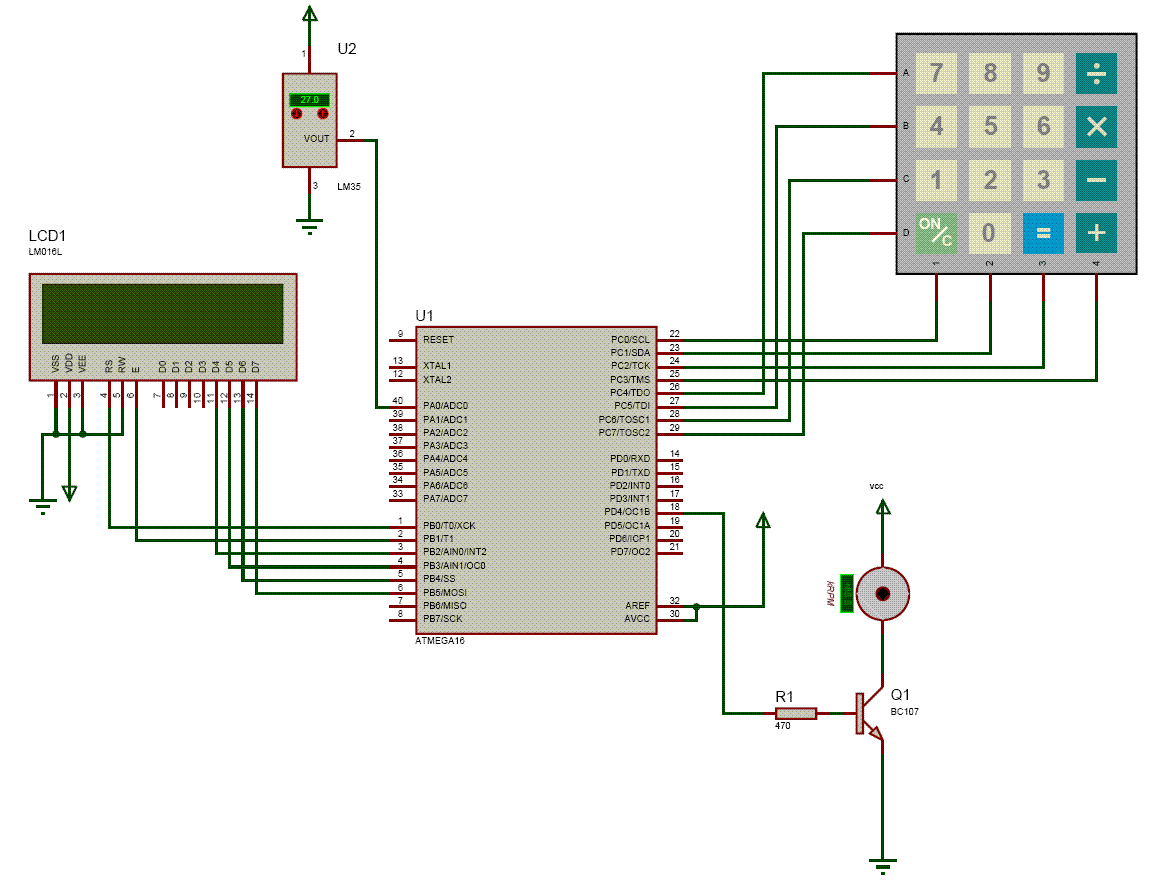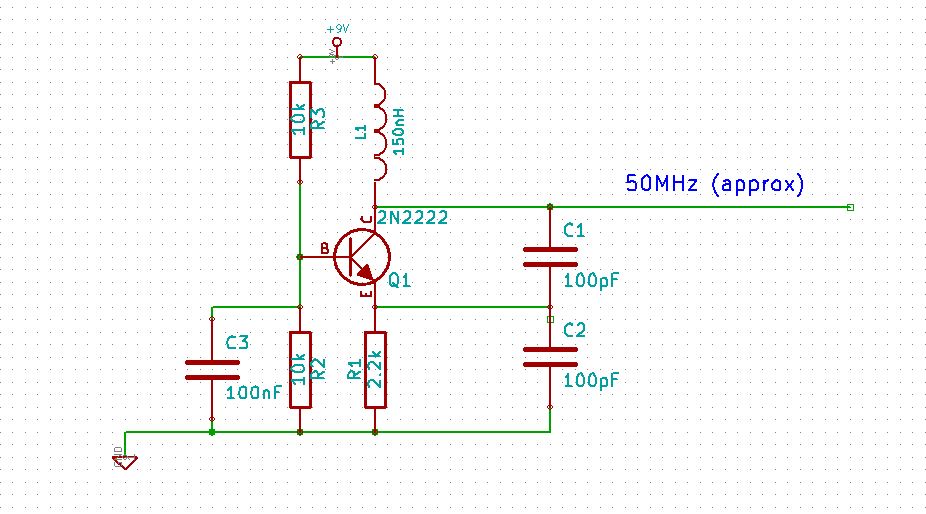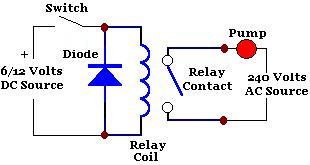
Deluxe Crystal Controlled Transmitter

A high-quality QRP transmitter, named NEXUS 6, is designed to explore issues related to extremely narrow bandwidth communication. This device is not merely a simplified version of a QRP transmitter; it aims to create a cost-effective system that can be easily reproduced by radio amateurs, utilizing simple circuit topologies to ensure high quality. Key considerations include extremely narrow bandwidth, phase noise, harmonic suppression, and distortion. These parameters can be challenging to optimize simultaneously, as improvements in one area may negatively impact another. The design employs discrete components wherever feasible, allowing for easier servicing and maintenance. The importance of coils and high-frequency ferrite transformers is acknowledged, as they help address inter-circuit issues; however, many radio amateurs may lack the necessary materials and skills to construct or test complex transformers. In the NEXUS 6 design, there is an effort to minimize the use of coils, although certain components such as bandpass filters and broadband transformers are essential. Many amateur radio operators overlook critical factors such as phase noise, distortion, harmonic suppression, and bandwidth. However, these considerations become crucial in ultra-low bandwidth applications, such as using NEXUS 6 as a backend for a microwave system. The transmitter is designed for QRSS operation and to facilitate a CDW data transfer system, which requires only a few hertz to exchange information effectively over long distances. Unlike most QRP circuits that are limited to a single band or a few bands, this approach aims for continuous coverage across a broadband spectrum of approximately 1-30 MHz. Achieving a broadband system without complex transformers is challenging, and careful selection of components is necessary to maintain linearity across HF bands. The NEXUS 6 employs techniques to minimize unwanted harmonics while maintaining broadband functionality without significantly increasing cost or complexity. Previous circuits encountered during research often failed to meet expectations, prompting the decision to refine existing designs to better meet specific needs. The construction of NEXUS 6 follows a well-tested schematic, and all components are included for specific reasons. Feedback and discussions regarding improvements are welcomed, as collaboration is encouraged among hobbyists.
The NEXUS 6 QRP transmitter circuit is designed with precision and functionality in mind, focusing on achieving a high-quality communication system capable of operating within extremely narrow bandwidths. The schematic incorporates a series of stages, including an oscillator, modulator, and amplifier, all optimized for minimal phase noise and harmonic distortion. The oscillator stage utilizes a crystal-controlled design to ensure frequency stability, which is critical for narrow bandwidth operations.
The modulator stage employs a direct conversion technique, enabling efficient signal processing while maintaining low distortion levels. The use of discrete components, such as BJTs or FETs, enhances the reliability and serviceability of the circuit. Each component's selection is made with careful consideration of its performance characteristics, ensuring that the overall system maintains linearity across the desired frequency range.
The amplifier stage is configured to provide sufficient gain while incorporating feedback mechanisms to suppress unwanted harmonics. This is achieved through a combination of passive components that form low-pass filters, allowing only the desired frequency components to pass while attenuating higher-order harmonics.
Coils and transformers, although minimized in the design, are strategically placed to address impedance matching and signal integrity issues. The bandpass filter is designed to isolate the desired operating frequency, ensuring that the transmitter operates efficiently within its designated bandwidth.
The NEXUS 6 is engineered to accommodate a wide frequency range from 1 to 30 MHz, making it versatile for various applications. The careful design considerations allow the transmitter to be used effectively in QRSS operations, where low power and narrow bandwidth communication are paramount. This adaptability is particularly advantageous for amateur radio operators seeking to experiment with different frequency bands while maintaining high communication standards.
Overall, the NEXUS 6 QRP transmitter represents a thoughtful integration of engineering principles, practical design, and user accessibility, making it a valuable tool for radio amateurs and a significant contribution to the field of narrow bandwidth communication.A high quality QRP transmitter, which I have named as NEXUS 6, in my try to explore the issues related to extremely narrow bandwidth communication. It is not just another QRP transmitter on a diet and I will explain why. The goal is to build a cost effective system that couldbe easily reproduced by radio amateurs, yet using simple circuit topologies that can make this system a high quality one.
Extremely narrow bandwidth, phase noise, harmonic suppression and distortion are greatly considered. These parameters are not always easy to combine, as each parameter may cancel the others. Discrete components were used where possible. Using discrete components you ensure that your construction will always be able to be serviced (as long as discrete transistors exist).
Building a high quality construction is not as easy as the Medifast diet, and burning out a component that is 20 years old may not be the best thing to do especially if this component is a specific microchip that has been discontinued. The consideration about coils is very important too. Coils and high frequency ferrite transformers are almost an essential part of any serious RF construction, as they solve many of the inter-circuit problems, but many radio amateurs do not have the right cores and the skills to build complex transformers neither the equipment to test them.
In some cases, impedance mismatching is not very crucial, especially in HF bands so some transformers could be replaced with more commonly available components. In Nexus 6, I try to avoid using coils where I can. Unfortunately some coils, (like the bandpass filter or the broadband transformers) are essential and cannot be omitted.
Many radio amateurs seem to ignore factors like phase noise, distortion, harmonics suppression and bandwidth in their systems. For example, as long as a transmitter transmits they do not care about such factors too much. But if you talk about ultra low bandwidth or if you use the Nexus 6 as a backend for a microwave system, then you should consider these.
Nexus 6 has been designed for QRSS operation and to test my CDW data transfer system that I have built. These systems need no more than a few hertz or tens of hertz to exchange information and they could be considered as the only fail-safe way to transfer information in ultra long distances using ultra low bandwidth.
If everything else fails they will work! Another point is that most of the QRP circuits that I have seen for shortwave is for a single band or for a few bands. In my approach I am trying to make a continuous coverage broadband system which can operate from about 1-30MHz.
Making a broadband system without using complex broadband transformers is not easy and even if you succeed then you may need to carefully chose the components to ensure that the system will be as linear as possible throughout the HF bands. Broadband systems and harmonic suppression are difficult and expensive to accomplish. Sharp variable filters may be needed and this is not an easy and cheap task. The techniques used in NEXUS 6 try to reduce unwanted harmonics without compromising the broadband behavior of the circuit and without raising the budget and complexity too much.
I have found many circuits on the web that did not work satisfactorily or they did not work for me at all. So I decided to use the working ones and perform my own adjustments to suit my needs. If you build the Nexus 6 the way I describe you, it will work. I have performed months of tests in order to build a good working system so please do not judge easily before you study or build the circuit by yourself.
Everything in the schematic has been there for a reason and there is nothing that is not needed. Since I am a hobbyist in electronics though, I will be glad to discuss with you any points you think that should have been done better, so 🔗 External reference
The NEXUS 6 QRP transmitter circuit is designed with precision and functionality in mind, focusing on achieving a high-quality communication system capable of operating within extremely narrow bandwidths. The schematic incorporates a series of stages, including an oscillator, modulator, and amplifier, all optimized for minimal phase noise and harmonic distortion. The oscillator stage utilizes a crystal-controlled design to ensure frequency stability, which is critical for narrow bandwidth operations.
The modulator stage employs a direct conversion technique, enabling efficient signal processing while maintaining low distortion levels. The use of discrete components, such as BJTs or FETs, enhances the reliability and serviceability of the circuit. Each component's selection is made with careful consideration of its performance characteristics, ensuring that the overall system maintains linearity across the desired frequency range.
The amplifier stage is configured to provide sufficient gain while incorporating feedback mechanisms to suppress unwanted harmonics. This is achieved through a combination of passive components that form low-pass filters, allowing only the desired frequency components to pass while attenuating higher-order harmonics.
Coils and transformers, although minimized in the design, are strategically placed to address impedance matching and signal integrity issues. The bandpass filter is designed to isolate the desired operating frequency, ensuring that the transmitter operates efficiently within its designated bandwidth.
The NEXUS 6 is engineered to accommodate a wide frequency range from 1 to 30 MHz, making it versatile for various applications. The careful design considerations allow the transmitter to be used effectively in QRSS operations, where low power and narrow bandwidth communication are paramount. This adaptability is particularly advantageous for amateur radio operators seeking to experiment with different frequency bands while maintaining high communication standards.
Overall, the NEXUS 6 QRP transmitter represents a thoughtful integration of engineering principles, practical design, and user accessibility, making it a valuable tool for radio amateurs and a significant contribution to the field of narrow bandwidth communication.A high quality QRP transmitter, which I have named as NEXUS 6, in my try to explore the issues related to extremely narrow bandwidth communication. It is not just another QRP transmitter on a diet and I will explain why. The goal is to build a cost effective system that couldbe easily reproduced by radio amateurs, yet using simple circuit topologies that can make this system a high quality one.
Extremely narrow bandwidth, phase noise, harmonic suppression and distortion are greatly considered. These parameters are not always easy to combine, as each parameter may cancel the others. Discrete components were used where possible. Using discrete components you ensure that your construction will always be able to be serviced (as long as discrete transistors exist).
Building a high quality construction is not as easy as the Medifast diet, and burning out a component that is 20 years old may not be the best thing to do especially if this component is a specific microchip that has been discontinued. The consideration about coils is very important too. Coils and high frequency ferrite transformers are almost an essential part of any serious RF construction, as they solve many of the inter-circuit problems, but many radio amateurs do not have the right cores and the skills to build complex transformers neither the equipment to test them.
In some cases, impedance mismatching is not very crucial, especially in HF bands so some transformers could be replaced with more commonly available components. In Nexus 6, I try to avoid using coils where I can. Unfortunately some coils, (like the bandpass filter or the broadband transformers) are essential and cannot be omitted.
Many radio amateurs seem to ignore factors like phase noise, distortion, harmonics suppression and bandwidth in their systems. For example, as long as a transmitter transmits they do not care about such factors too much. But if you talk about ultra low bandwidth or if you use the Nexus 6 as a backend for a microwave system, then you should consider these.
Nexus 6 has been designed for QRSS operation and to test my CDW data transfer system that I have built. These systems need no more than a few hertz or tens of hertz to exchange information and they could be considered as the only fail-safe way to transfer information in ultra long distances using ultra low bandwidth.
If everything else fails they will work! Another point is that most of the QRP circuits that I have seen for shortwave is for a single band or for a few bands. In my approach I am trying to make a continuous coverage broadband system which can operate from about 1-30MHz.
Making a broadband system without using complex broadband transformers is not easy and even if you succeed then you may need to carefully chose the components to ensure that the system will be as linear as possible throughout the HF bands. Broadband systems and harmonic suppression are difficult and expensive to accomplish. Sharp variable filters may be needed and this is not an easy and cheap task. The techniques used in NEXUS 6 try to reduce unwanted harmonics without compromising the broadband behavior of the circuit and without raising the budget and complexity too much.
I have found many circuits on the web that did not work satisfactorily or they did not work for me at all. So I decided to use the working ones and perform my own adjustments to suit my needs. If you build the Nexus 6 the way I describe you, it will work. I have performed months of tests in order to build a good working system so please do not judge easily before you study or build the circuit by yourself.
Everything in the schematic has been there for a reason and there is nothing that is not needed. Since I am a hobbyist in electronics though, I will be glad to discuss with you any points you think that should have been done better, so 🔗 External reference
